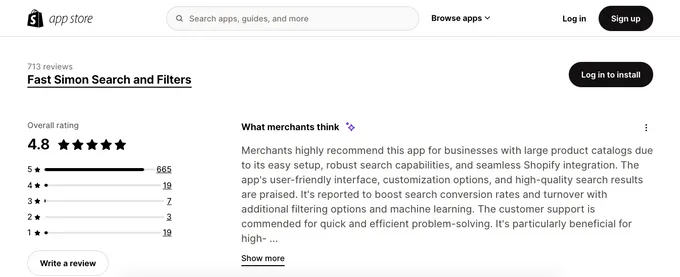A Guide to Internal Search Metrics of Your Online Store
How are your customers interacting with the search function on your website? Use these seven essential eCommerce search metrics to enhance their shopping experience.
Updated September 3, 2025

The search bar on your online store is more than just a tool for your customers; it’s a valuable source of data that helps you better understand their needs. By focusing on eCommerce search metrics, you can track important trends and make informed decisions that improve user experience.
Whether you’re using Magento search or Bigcommerce search apps, analyzing your search function can provide important insights. We'll help you understand which internal site search metrics to focus on and how they can benefit your business, ultimately improving the shopping experience and driving conversions.
» Boost your site search capabilities with our eCommerce search tool
Meet the Expert
Jameela Ghann is a seasoned online store owner with over a decade of eCommerce experience. Apart from running Alora Boutique, she's also the marketing manager for Fera Product Reviews.
» Want to take search to the next level? Check out the best practices for eCommerce site search.
External vs. Internal Search Metrics
External metrics, tracked through tools like Google Search Console, reveal how users discover your site via external search engines. They provide valuable insights into search performance, helping you understand which keywords and pages drive the most traffic.
These metrics focus on:
- Searches per visit: The number of searches users conduct during a visit.
- Percentage of people using search: The portion of visitors who use the internal search functionality.
- Search exit rate: The percentage of users who leave your site after performing a search.
- Search refinements: The number of times users modify or refine their original search query.
Internal metrics provide a deeper understanding of user intent, customer engagement, retention, and conversion. They help assess customer satisfaction and business outcomes, and can provide insights for your merchandising strategy.
Ultimately, internal search metrics play a pivotal role in:
- Making informed decisions
- Enhancing user experience
- Better personalization
- Boosting conversions
- Improving overall business outcomes
Pro tip: Analyze the percentage of users who make a purchase following a search. This data offers insights into the efficiency of your site’s search experience.
» Learn how to navigate and analyze internal site search
7 Key Internal Site Search Metrics
Different metrics measure how well your site’s search function works. They give useful information about user behavior and how your Shopify search tools perform. Now, let’s take a closer look at each of these internal search metrics.
1. Search Exit Rate
This metric is the percentage of customers who leave your site after conducting a search without clicking on any results.
How to calculate: (Number of exits after a search / Total searches) * 100
It gives you an idea of how well your search results are meeting the needs of your customers. If you’re running an eCommerce site and your product pages and checkout page have an exit rate of 20-40%, you’re doing pretty well.
But if the exit rate is higher, it could mean that your store’s products might not be categorized well or they might not be what your customers are looking for.
2. Search Relevance
Internal search relevance measures how effectively your website connects user queries to relevant results. A good query-to-result score means that customers can find products quickly and easily, which improves merchandising metrics and leads to:
- Better traffic
- Higher CTR
- Improved conversion
- Increased sales and revenue
Benchmarks vary, but a balance between accuracy and recall is crucial for quality search results. To optimize this metric, you could:
- Use several sources when creating datasets, for better search quality.
- Improve on-page and off-page SEO, especially titles, tags, descriptions, meta descriptions, and hierarchy.
- Draw insight and apply conclusions from analyzing CTR, conversion rates, user behavior, and customer feedback.
» Want to grow your eCommerce business? Check out our best searchandising strategies.
3. Site Search Accuracy
Site search accuracy tells you how often your search actually hits the mark. It's a simple calculation of the proportion of relevant results among the total searches.
How to calculate: (Number of accurate search results / Total search times) * 100
This gives you the percentage of spot-on results.
While search relevance and accuracy are related, they're not quite the same. Relevance reflects how well your search engine understands user intent, while accuracy measures how often it provides the exact matches users need.
High accuracy means fewer dead ends and fewer lost customers. Users quickly find what they’re looking for, leaving them satisfied and lightening the load on your support team.
» Take a look at these best practices for site search
4. Null Result Rate
Ever type a query in the search bar, only to be met with...nothing? That's the null rate in action. It's the percentage of searches that leave users staring at a blank page.
How to calculate: (Number of no results / Total search times) * 100
The average null rate is 10 to 30%. Anything higher than that could indicate:
- Missed opportunities for conversion
- Chance to highlight new product offerings
- Need to optimize SEO
» Struggling with search? Learn how to troubleshoot "no search results found"
5. Site Conversion Rate
This is one of the most important metrics since it shows the conversion rate of visitors via the search tool.
How to calculate: Site conversion rate = (Total Conversions from Search / Total Searches) * 100
Despite its power, the site conversion rate is often overlooked. However, it can be a valuable tool for bridging the gap between relevant keywords and product optimization.
Generally, a 2-4% overall conversion rate is considered good in eCommerce. For site conversion rate, expect to see numbers closer to 2-3%.
Lower rates can indicate problems with search relevancy or product presentation. If this is the case, reevaluate your search strategy. Optimize both the search function and product information for improvements in this critical metric.
» Here's how to craft the best product descriptions.
6. Percentage of Site Visitors Using Search
This metric shows the percentage of visitors who actively use your site’s search bar. While it may not be as insightful as some of the other metrics, it gives a quick indication of whether your search feature is valuable to users.
If a low percentage of visitors are using search, consider exploring visual discovery options to engage shoppers who may prefer browsing visually over typing queries.
» Learn why you should add visual discovery to your store
7. Searches Per Visit
Searches per visit reveal how many searches users typically perform during a single visit.
Ideally, the number should be low, indicating users find what they need quickly and easily.
To optimize searches per visit, consider:
- Choosing the right search provider
- Understanding metrics like search relevance and accuracy
- Analyzing customer behavior and search data
- Improving search box visibility
Optimizing Search Functionality
Regularly monitoring these seven metrics allows businesses to refine their approach and optimize their site's search functionality. Collectively, the numbers above offer:
- A comprehensive view of your internal search performance
- Guidelines for improving customer experience
- Better product categorization
- Improved overall search strategy
- More advanced online merchandising solutions
» Here are more tips to improve the customer experience on your site
Additional Tips to Optimize Your Internal Search Engine
Set Ranking Rules
Enhance your internal search by setting ranking rules that prioritize relevant products. Use factors like product category, stock levels, or discounts to determine which results show first.
Implement Typo Tolerance
Many customers make typos when searching. By using machine learning-based typo tolerance, your internal search engine can identify and correct errors, ensuring customers still see relevant results, minimizing "no results" pages, and improving the user journey.
Incorporate Synonyms
Customers often use different terms for the same products (e.g., "shirt" vs. "t-shirt"). Implementing synonyms in your internal search eCommerce setup ensures users find products regardless of their word choice, creating a smoother search experience.
Conduct A/B Testing
Use A/B testing to compare different versions of your search configurations, like ranking rules or filters, and discover which setup drives higher sales. Site search metrics can then reveal the features that resonate most with users, providing insights for further optimization.
» Here are 6 more ways to improve internal site search optimization
Bonus: Best Tools for Internal Search Metrics
Whether you're on a budget, looking for Shopify integration, or require advanced analytics, you can use tools to get the right information. Each of these top three tools provides different functionalities, so your business can find a suitable match to your specific needs.
How Internal Search Metrics Might Change in the Future
As technology advances, AI's benefits in eCommerce continue to expand. And internal search metrics are likely to evolve, too. Here's a glimpse into how these changes might unfold:
- Evolution beyond traditional metrics: Traditional measures like relevance and accuracy might fade as AI becomes more prominent. This includes advanced technologies like natural language processing and natural language search.
- Integration of new search techniques: Emerging search techniques, such as vector search and hash search, are expected to play a major role. A hash in search is a unique code generated from information, like a condensed summary. This allows for faster searching by comparing codes instead of full data.
- Built-in accuracy in search tools: With the integration of AI into merchandising, search tools like AI visual discovery or AI predictive search will likely come to the forefront of search engines.
- Cross-site recommendations: A potential future trend could involve cross-site recommendations. Smaller stores might showcase other stores' products, creating opportunities for personalized search recommendations and collaboration.
- Shift from traditional keyword searches: With AI-driven search tools, the use of traditional keyword searches might decline. The focus may shift to AI capabilities for a more intuitive search experience and even more opportunities for personalization.
Raising the Search Bar With Internal Metrics
Your online store should be flexible, adaptive, and value-driven. Optimizing eCommerce site search strategies is a cost-effective and efficient way to stay aligned with customer habits and relevant queries.
With proper AI search tools, store owners can gain deeper insights into what customers are searching for and how they interact with the site. This allows for a more granular understanding of user behavior, enabling you to offer personalized shopping experiences. Ultimately, improving internal search metrics leads to higher satisfaction, increased engagement, and better conversion rates.
» Looking for a search tool? Take a look at our search solutions









